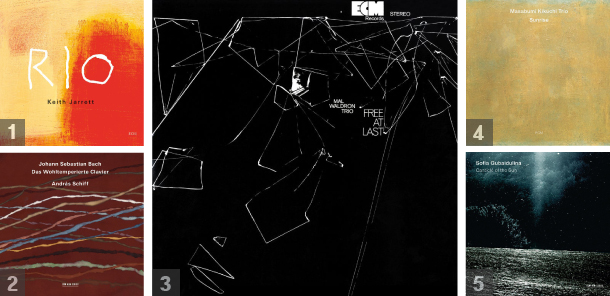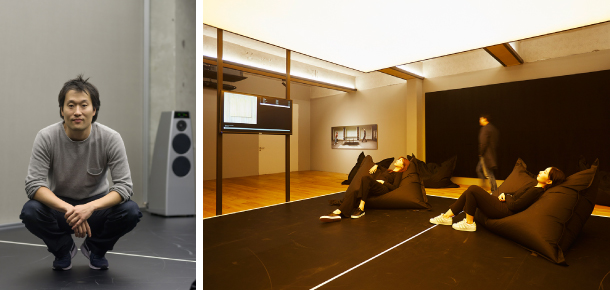Diving deep into the history of ECM Records: Exhibit explores the impact of the famed German music label

1. Keith Jarrett’s “Rio” (2011) 2. Johann Sebastian Bach’s “Das Wohltemperierte Clavier” (2012) 3. ECM’s very first album released on Jan. 1, 1970, “Free at last” by the Mal Waldron Trio. 4. “Sunrise” by Masabumi Kikuchi Trio (2012) 5. “Canticle of the Sun” by Sofia Gubaidulina (2012) [ECM RECORDS]
Munich-based record label ECM, founded by its still de-facto art director Manfred Eicher, celebrates its 50-year anniversary this year. To mark this special occasion, ECM decided to put on an exhibition in Seoul in conjunction with Hyundai Card, a company that has organized some of Korea’s biggest music-related events over the past few years.
Both companies insist that their “RE:ECM” exhibition, which kicked off at the Hyundai Card Storage in Hannam-dong, central Seoul, on Oct. 18, is something that has never been seen before.
“Hyundai Card is known for hosting many Super Concerts and has its own Music Library and a wide collection of vinyl,” said an official from the company, “but this is in fact the company’s first music exhibition. We decided to work with ECM and celebrate its 50th anniversary because we believe ECM is a record label that has become almost like a music genre unto itself and continues to influence people without falling behind in this rapidly changing world.”
ECM has been holding various exhibitions in cities around the world over the past years. But according to Chung Seon, an ECM producer who is also widely known to Koreans as the second son of famed maestro Chung Myung-whun, “‘RE:ECM’ is different from all of the previous ones.”
“Instead of communicating through ECM’s point of view,” said Chung Seon, “this time it’s turning things around and communicating through a listeners’ perspective. We’ve selected six art groups to reinterpret ECM’s impact on the history of contemporary music in their own ways and unveil their variations. We hope this will start various conversations, not only about music, musicians and the history of the ECM itself, but also about the culture of listening to music.”
The exhibition features the entire ECM Records music catalogue since Jan. 1, 1970 - a total of nearly 1,600 albums. In Hyundai Card Storage’s basement floor, all of ECM’s albums, from the very first to the most recent, are currently being played nonstop, even when the space is closed. This section of the museum is “Small Places,” created by German sound designer Mathis Nitschke.

Left: Chung Seon, ECM producer, visits Korea to introduce its latest exhibit “RE:ECM” at the Hyundai Card Storage in Hannam-dong, central Seoul. Right: The entire ECM Records catalogue is being played nonstop at the exhibit as part of the piece “Small Places.” [HYUNDAI CARD]
At noon on Oct. 18, when the exhibit opened, the Small Places piece began playing ECM Records’ very first track off of its very first album, “Free at last” by the Mal Waldron Trio. Visitors can check out what music is playing at the museum by going to the work’s website (www.smallplaces.art).
Nitschke said he was inspired by a famous photograph of pianist Keith Jarrett and Eicher playing Ping-Pong together during a break from recording. The photograph, which was taken by ECM Records’ sound engineer Peter Laenger, is also displayed in this section.
“I wanted to use Ping-Pong as a metaphor for producing music,” said Nitschike, who visited Seoul for the exhibition. “Ping-Pong and music have similarities as both require communication between [two people]; music needs a listener and so on. There’s this spontaneous oddity and the sense of ‘being in the moment.’”
On the upper floor, visitors can see the rest of the artworks on display, including American artist Rick Myers’ piece titled “Recollection 1969-2019,” which is comprised of a visual array of light that uses the original ECM logotype as its source. There’s also British artist Sam Winston’s “Between noise and sound,” in which the artist worked on while listening to four songs from John Cage’s album “As It Is” released by ECM. The artist listened to the songs on repeat and recorded his responses to each of them in a drawing.
“I want to introduce my work with a quote by Gertrude Stein. She said, ‘A writer should write with his eyes and a painter paint with his ears.’ In this contemporary world, we usually consume music as a piece of digital culture. It’s very quick. But I think ECM treats music as an invitation to go deeper into the act of listening,” said Winston. “So I decided to go with this particular artwork to show the process of going deeper into the music. It shows a different way of listening to John Cage’s music.”
In a darker room separated with a curtain, there’s Lars Ullrich and Nitschke’s video artwork “Flow.” Visitors can take a seat and listen to ECM’s music and watch a 3-D animation on the screen created by the two artists. According to Nitschke, the movements on the screen are “responding to the music by analyzing it, which can also be heard by the visitors through the earphones.”
“At the core of ECM’s music lies the idea of horizontal development, that music never stops flowing and developing,” the artist said. “That there’s a constant stream of time. This installation lets visitors experience this horizontal development by involving them in an analysis and visualization of the inner flow of music through digital animations.”
The colors that are being used for the 3-D objects on the screen, according to the artist, are taken from the colors of the specific album cover of the music that is being played.
Korean artist Seo Hyun-suk also participated in the exhibition with a work that requires participation. While viewing “Parallel Lines,” visitors are required to go into a dark room wearing a VR headset. Here, visitors can listen to an imaginary dialogue between Eicher and an unknown musician inside a car.
According to Seo, although the conversation is fabricated, the excerpts are all from interviews from Eicher and various artists of ECM including Keith Jarrett, Arvo Part and Jan Garbarek.
“I wanted to show the thinking behind ECM music,” said Seo.
In the final section of the exhibit, visitors will encounter “Murmuration,” an installation that encompasses a retrospective of about 220 selected ECM album covers printed on transparent material.
Created by London-based creative group MMBP, this installation of transparent album covers hover above the gallery floor, allowing visitors to be able to “fully appreciate Eicher’s process of creation, which is methodical, precise yet fluid and organic.”
BY YIM SEUNG-HYE [sharon@joongang.co.kr]










with the Korea JoongAng Daily
To write comments, please log in to one of the accounts.
Standards Board Policy (0/250자)